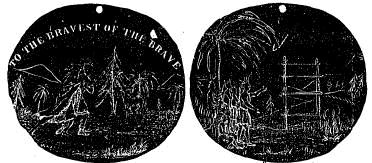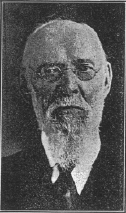|
This unique and interesting medal was
found in the extreme western part of Nance county, in 1883,
by two people who unearthed it from an Indian grave, and
presented it to the present owner. Mrs. G. W. Ellsworth, at
645 North 30th St., Lincoln, Nebr.
The grave was not far from the banks of
Spring Creek. a small stream which enters the Loup river
about fifteen miles northwest of Fullerton, Nebr. In the
same grave they found glass beads and other trinkets which
showed contact with whites.
This is all that is really known about
this medal. It is the first silver Indian medal to come into
the rooms of the Nebraska State Historical Society; and
probably the most interesting Indian relic ever found in
Nebraska.
A careful study of the accompanying full
sized cuts suggests that the medal was probably engraved to
commemorate a brave act. The two figures escaping toward the
two horses in the grove nearby suggests that the hero was an
Indian rescuing a white woman from captivity. The ravine
illustrates the recital of his exploits around the camp
fire. The legend tells that it commemorates the deeds of
"the bravest of the brave." If we could know the historic
facts in all the details it would doubtless make an
interesting story.
The best authority on engraving says the
work was doubtless done by hand with a tool used to engrave
dies or patterns for stamping. That the engraver had skill
of marked ability is evidenced by the specimen. The
engraving was done without shading in the lines, and
pictures of this class were common from 1600 to 1800. The
technique of the drawing places it before 1800. - E. E.
B.
The following letter from Rev. M. A.
Shine, of Plattsmouth, to Curator Blackman, at the
Historical Society Museum, is full of interest:
Plattsmouth, Nebr., January 21, 1919.
My Dear Mr. Blackman:
Here are a few notes in regard to that
silver medial which you so kindly allowed me to examine, on
the occasion of the annual meeting at the State Historical
Society, a week ago.
As you remember, we most emphatically
disagreed in regard to the particular band of Pawnee to
which which the Pawnee, Pi-ta-le-sha-ru or MAN CHIEF,
belonged.
As I see it now, we were both right in our
contentions, for we were talking about two men with the same
name, but with entirely different characteristics, and
living at different periods of time in the history of the
Pawnee tribe.
I spoke of Pi-ta-le-sha-ru, or MAN CHIEF,
or CHIEF AMONG MEN, (Hdbk. of Am. Inds. II, 236), a Pawnee
brave or warrior, the son of La-clie-le-sa-ru or KNIFE
-CHIEF (Hdbk. II-118), the Head Chief of the SKIDI or WOLF
PAWNEES, at this time (1817-1821), as the man who received
this medal in Washington. D. C., in 1821, on account of his
brave act in 1817 in rescuing a Comanche girl from the
?sacrifice to the Morning Star. (Drake , Inds 635.) Pawnee
Stories, Grinnell, 363-434. For details, etc., of Skidi
Sacrifice, see Pawnee Stories, 363-368.)
You had in mind the Chaui or Grand Pawnee
Chief, Pi-ta-le-sha-ru, who was born, about 1823 (Blackman
in H. of Neb. I-43; Kans. Cols. X.) survived the smallpox
epidemic of 1837-38, and was made head chief of the
confederated Pawnee tribes in 1852, and who died about
1874.
In regard to my man: Pi-ta-le-sha-ru, the
SKIDI warrior, was born about 1796 or 1797. among the Skidi
tribe, in what is now Nebraska. He was about 20 years old
when he ignored and disregarded the sacred and religious
traditions of the Skidi Pawnee tribe, by rescuing and
leading to safety this Comanche maiden who was destined as a
victim and burnt offering to the Great or Morning Star, one
of the tutelary gods of the Skidi tribe.
However, it is well to bear in mind, that
during this very same
|
period of time (1817-1821) there was another man named
Pi-ta-le-sha-ru, or MAN CHIEF, who was one of the head
chiefs of the Kit-ke-hah-ki, (i. e., Small or Little
Village), or Republican Pawnee, who had received in June,
1818, a chief's medal from Gov. William Clark, in St. Louis,
Mo. I am inclined to believe that many writers have confused
the names of these two men.
At any rate, Pi-ta-je-sha-ru, the Skidi
brave or warrior, accompanied his father, LA-CHE-LE-SHA- RU,
or KNIFE CHIEF, the head chief of the Skidi Pawnee, with at
number of other Indian chiefs to Washington, D. C., in 1821.
While there the fame of his remarkable bravery in such a
glorious act having preceded him, the young ladies of a Mrs.
White's seminary presented him with a special silver medal,
in honor and commemoration of his brave act. (Drake, Inds.
635.)
While I have no direct and incontestable proofs
for its identification, yet I am fairly convinced that this
silver medal is the identical medal presented by these young
ladies, and that the grave in which it was found was that of
Pitalesharu, the Skidi Warrior, THE CHIEF OF MEN, or THE MAN
AMONG MEN, or as the medal itself translates his name, THE
BRAVEST OF THE BRAVE.
Yours sincerely,
Rev. Michael A. Shine.
P. S. - Grinnell describes the altar or
framework engraved on the medal. See Pawnee Stories, p. 364,
last four lines.
Spelling of Nebraska Indian names varies greatly in
different books and in different periods. Spelling used by
Father Shine we have let stand. It may be worth while to
state the spelling given in the Handbook of American Indians
(Vol. 2, p. 236), Petalesharo, with the following variations
in the article: Petarescharu, Pe-tah-lay-sha, Petanesharo.
The spelling of the name of Knife Chief is given in the same
volume, page 118, Latalesha with the variations at
Settulushaa and Letereeshar. The standard of spelling
adopted by the Nebraska State Historical Society is that
used by the Bureau of American Ethnology.
BASE HOSPITAL NO. 49 NURSING
PERSONNEL.
(Continued from Fourth Page.)
Schreiber, Orma A., Alma, Wisconsin.
Shepard, S. Julia, Alexandria, Minnesota.
Smart, Nellie Hunt, World Herald Bldg., Omaha, Nebraska.
Smith, Jessie, 1406 North Broad Street, Fremont,
Nebraska.
Smith, Zella A., Roca, Nebraska.
Sullivan, Minnie M., Grace, Idaho.
Svitak, Emma L., Chapman, Nebraska.
Thode, Martina C., 777 Scott Street, Milwaukee,
Wisconsin.
Vance, Evangelyne F., Exeter, Nebraska.
Wagner, Maybelle, Virgil, Kansas.
Weller, Hedwig, 1916 South 32nd Avenue, Omaha, Nebraska.
Westerdahl, Viva E., Fulda, Minnesota.
Wilkinson, Grace E., Cedar Bluffs, Nebraska.
Windmeyer, Connie, Naper, Nebraska.
Wishart, Irene L., 92 Avenue Road, Toronto, Canada.
Wooster, Dorothy, Silver Creek, Nebraska.
Wright, Ethel M., Belt, Montana.
CIVILIANS.
Jess, Irene H., 2722 Howard Street, Omaha, Nebraska.
Naughtin, Patricia L., 5017 Davenport Street, Omaha,
Nebraska.
O'Sullivan, Eva F., 4800 Lindale Ave., Minneapolis,
Minnesota.
Rusland, Muriel, Omaha, Nebraska.
|

